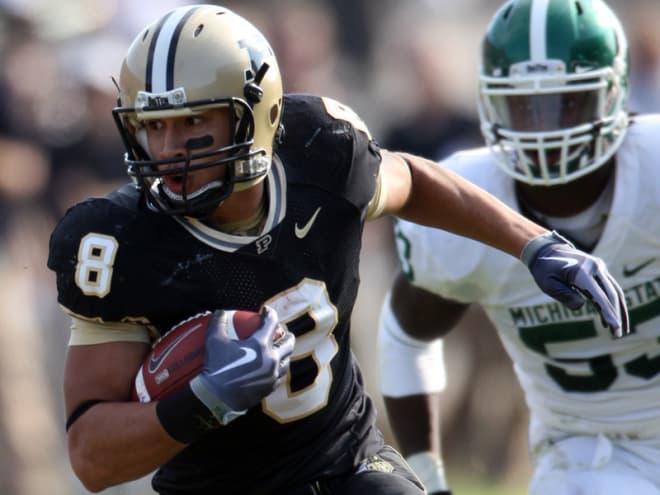The Best I Played With: A player's perspective, Keith Smith
Player perspective series: Joe Holland | Chris Clopton | Ryan Kerrigan | Travis Dorsch | Chukky Okobi | Charles Davis | Joey Elliott
"Catching Up" series ($): Akin Ayodele | Matt Light | Bernard Pollard | Brandon Villarreal | Kory Sheets | Adrian Beasley | Billy Dicken | Shaun Phillips
GoldandBlack.com's 20-year player draft ticker: Nos. 1-91
GoldandBlack.com staff is making its decisions about Purdue's best players since 1997 with a 20-year player draft that'll run through July.
In conjunction with the draft, we also will check in with former Boilermakers to get their perspectives on the best players they played with during their careers. They offer up behind-the-scenes looks at intense work ethics, how players got the most out of their teammates and even reflect on funny stories during their days together.
Next up is Keith Smith, whose 1,100-yard season in 2009 was the last one of 1,000-plus yards for a Purdue receiver, as told to Stacy Clardie:

"There are two that really stand out to me.
"One was Dustin Keller. Athletics and being a student-athlete really came across (in him), and that helped me instill that into myself and continue passing that along. He embodied it not only because he put in the work in the weight room and on the training ground, but it was behind the scenes that was so great. Especially for him being a hometown guy. Seeing the way he interacted with the community. Any time he had an opportunity to give back to the community, he’d helped out. Not only that but help with his family and show that there’s a way to embrace who you are as an athlete, but use that and he turned himself in a great direction as a man. During that time, we had a great coaching staff, headed by Tiller, and it stemmed from him, how he directed the team and created that brotherhood we had there. I think D.J., he was the embodiment of it. It was nice to see because I remember my freshman year, I was into the locker room, it was during two-a-days, and he walks in. My locker was close to the entrance. I have wings tattooed on my back, and he was like, ‘Oh, you have wings. I sure hope you can fly.’ (laughs) He teased me for weeks upon months until he finally came by one day, it was midseason my freshman year, and he was like, ‘I’ve been messing with you all year, but I have to give it to you. You fly and you show that you work. We love that. Continue showing that throughout your career.’ Just the way he embraced the on the field, the off the field, the constant grind, I think he, to me, embodied Purdue football to a whole. He commanded my respect from Day 1 and to this day, he still has my respect.
"The second guy is someone that gets overlooked quite a bit, but he was another embodiment, and it was Stanford Keglar. He was an animal. He really was. He was a specimen upon specimen, and he was that hybrid linebacker/D-end before that position was really even created. He was 240-something pounds, ran a high-4.4, low-4.5, was strong as can be, but the thing that was overlooked so many times with him was how intelligent he was. I had so much trouble manipulating him throughout my career during practice because what he did off the field is what helped him on the field. What so many people sometimes lack is studying of game tape and film and correcting the minor mistakes you made the day before. After practice, he would go into the locker room and go watch film, on his own. He would prepare himself for that next step to make sure whatever I might have got him on Day 1, come Day 2, there’s no way I’m going to get him on that again because of the fact he already saw what he did, he saw the mistake he made and he’s not going to make it again. That’s one thing that got lost in translation with him. Everyone always sees him as such a physical specimen that his intelligence was overlooked. I would say that was probably his strong suit — he was so smart on the field that he knew what was coming. So he could put himself in position to stop the play or get close to stopping the play or direct somebody that put them in a position to stop the play. That’s where he really was that quarterback of the defense and made sure everybody was in the position they were supposed to be."

Membership Info: Sign up for GoldandBlack.com now | Why join? | Questions?
Follow GoldandBlack.com: Twitter | Facebook
More: Gold and Black Illustrated/Gold and Black Express | Subscribe to our podcast
Copyright, Boilers, Inc. 2017. All Rights Reserved. Reproducing or using editorial or graphical content, in whole or in part, without permission, is strictly prohibited.

